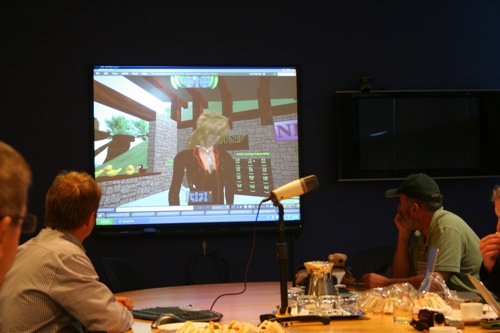Christian Salles, Olivier Lamirault, Serge Soudoplatoff, Jean Michel Billaut and Franck Bellido are five impressive individuals. All from France, they have played various roles in France’s technology sector (their full bios follow at the end of this post) and they intrinisically understand virtual worlds. One (Franck Bellido) developed his company’s Second Life island presence.

Over the past week these five have been on a mission to see how Australia utilises virtual worlds and it’s been quite a tour. They’ve spoken with key people at VastPark, NICTA, AFTRS, SLCN, ExitReality, Skoolaborate,CLI and Smart Services CRC to name a few.
In the few hours I spent with the team from France, I was struck by their passion for the subject and their obvious respect for the work being done in Australia with virtual worlds. It was also a stark reminder of Australia’s lack of broadband infrastructure when seeing their reaction to our broadband speeds, which makes achievements to date locally even more impressive in a lot of ways.
Sometimes it takes a collaborative occasion like this to really bring home the fact that Australia well and truly has a virtual worlds industry – one that attracts interest worldwide.
A big thanks to Mandy Salomon at Smart Services CRC for the invite to take part.
=========
The bios:
Christian Salles career in applied research spans 35 years working in France, Norway, Taiwan and Frankfurt with the banking conglomerate BNP Paribas. Mr Salles pioneered intranet technologies in 1996, overseeing 200 installations including that of Reuters. More recently, Christian created his own consulting firm, Back End Office and is a professor at Paris’ Dauphine University.
Jean Michel Billaut consults on technology and innovation at the highest level of government and industry. His career with the Euro bank BNP Paribus has included Senior Economist and ‘VP in charge of Communication’. He is currently their advisor on the Internet. Jean Michel has chaired the ‘Centre d’information et d’etudes sur le credit’, a research organisation on credit, savings and financial problems and since its foundation in 1993, chairs ‘Club de l’Arche’, a multi-disciplinary thinktank to exchange information and thoughts on the introduction of new information technologies and the communication in society. In 1983, Mr Billaut launched Atelier, the first financial telematics service in France, and is chief editor of ‘Journal de l’Atelier, a review on technologies and marketing for professional organisations. Jean Michel was amongst the first to implement BBS systems and launched one of the first websites in France, ‘Web de l’Atelier’ (1994). In 1998, he created Canal Atelier, France’s first video streaming channel. As advisor to the provincial city of Pau, Jean Michel oversaw the introduction of innovative internet services underpinned by an optical/wifi network of 100 megabits for 30USD /month. Between 1998 and 2002, Jean Michel chaired the ‘Digital Towns Association’ and is currently lobbying for a ‘new deal’ in Europe: to build a fibre optic infrastructure end-to-end all over Europe. Jean Michel has written widely on the net economy and holds degrees in economic science (PHD) and informatics. He was awarded the distinction ‘Chevalier de la Legion d’honneur’, by President Chirac for the promotion of the Internet in France.
Serge Soudoplatoff is the president and co-founder of Almatropie, an association devoted to the promotion of innovative Internet usage. As such, he continues a distinguished career on the leading edge of high technology. He has recently founded Commonbox, a company devoted to simplify money pooling, and make it more cooperative. He is a co-founder of the multi-national provider of pricing, rating & charging solutions, Highdeal. Prior to that, he was Director of Innovation for France Telecom, driving the telco giant’s work group defining Internet policy and action plans. As such, he launched projects on mobility and the Internet, corporate IP telephony, and the services and new economic models needed in the Internet age. Before joining France Telecom, Serge managed the innovation research centre in Paris for Cap Gemini. He also did research on speech and pattern recognition at IBM research labs in Yorktown Heights, NY, and spent several years as a university professor. He began his career as a geographical engineer for the French national geographical institute, doing image recognition and satellite positioning. Mr. Soudoplatoff is a former secretary-general of the French professional group, CP2i, comprising research organizations with the joint aim of promoting high tech innovation. Serge teaches Internet and strategy at Hetic, the school of the Internet, and at ESCP-EAP. He has an engineering degree (PHD) from France’s equivalent to MIT, Ecole Polytechnique, and is the author of “Avec Internet, où allons-nous ?†Le Pommier, 2004. (‘Where are we going with the Internet’) The book is downloadable. In addition to speaking fluent English and French, Serge is conversant in Russian.
Olivier Lamirault
Oliver has been working on eLearning solutions since 1992. As director of Ingenium, he is devoted to the development of Ingenium and building the Ingenium team. The objective is to maintain Ingenium as a leader in the field of eâ€learning. Olivier designs and realizes the pedagogical engineering of Ingenium partners. He manages projects and monitors the production to ensure the quality and the relevance of teaching resources produced. Technology and pedagogy play an important role in its activity. The remaining time is devoted to developing relations with external partners.
Franck Bellido
Franck is the Flash and 3D developer of Ingenium. He is responsible for achieving the development of complex flash animations which required coding in the language actionâ€script. Franck also develops elements into 3D environments for Ingenium’s video production and illustrations. Franck develops VirtuaLearn, the Company’s learning and collaborative island in Second Life.

Recent Comments